
Successful Turkey Hunting: A Proven Approach
On the surface, the thought of heading into the woods to shoot a turkey seems simple. Listen for a gobble, move in its direction, make a few imitation calls, and take your shot. After all, they have brains the size of a peanut and lack a strong sense of smell.
Should be easy, right? Wrong!
You’ll quickly realize chasing turkeys requires a distinct skill set. This article is going to provide the knowledge you need to develop these skills and harvest your first bird or more turkeys in general.
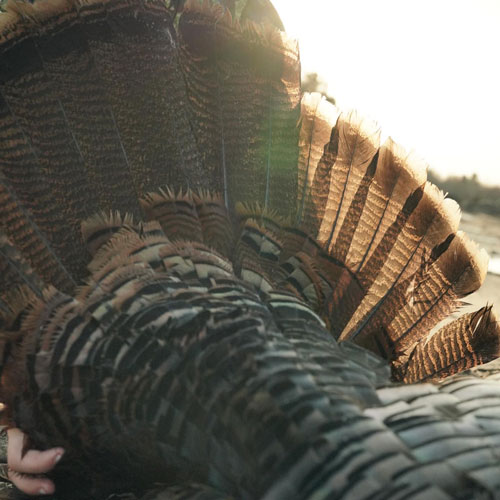
Image Credit: Hazy Mountain Media
Part 1 – The Best Time to Turkey Hunt
SPRING —the time we get to leave the house and enjoy the sunshine.
It’s also the best time to turkey hunt.
Spring is when male turkey, or toms, are more active and vocal, strutting around and showing off for the hens. This season falls from late March through late May, depending on the location and climate. Be sure to check your local regulations for season information.
Another time of the year when turkey hunting is open is the fall when most folks are out deer and elk hunting. During this timeframe, it’s a good idea to keep a turkey tag in your pocket just in case. During fall season, keep in mind that birds often travel in flocks and can be a little trickier to hunt, as they won’t be in peak breeding season or roaming around alone. They tend to be smarter in flocks.
The Best Time of the Day to Hunt Turkeys
The early worm gets the bird!
If you’re not a morning person, now is the time to become one. Why? Because the best time to hunt turkeys is typically shortly after first light. Get out to your blind early and listen for the yelps, cackles, and gobbles of turkeys as they start their search for breakfast. You might even get lucky and catch one flying off the roost.
Turkeys are most active in mild weather. As a general rule of thumb, turkeys are most active during calm, clear days in the morning and early afternoon hours. Studies show that they are the most vocal when the temperature is between 60 – 69° Fahrenheit. Much like humans, if it’s too hot or too cold their activity slows down.
You might think that rainfall puts a damper on turkey hunting, but you’d be wrong. Rainfall is great for turkey hunting, contrary to popular belief.

Image Credit: Hazy Mountain Media
Part 2 – Where to Hunt Turkeys
The truth is, you should hunt wherever you see the most turkeys—assuming you can legally access that area, of course.
If you’re driving around and see a pile of birds in a farmer’s field, don’t be afraid to call or knock and ask for permission. There’s also a ton of public land available to hunters, so don’t hesitate to venture onto public land because you think it will be loaded with other hunters. Chances are, there are plenty of places that folks aren’t willing to walk to or areas that most people don’t go. Searching for hidden gems requires additional work and scouting time, but it usually pays off.
Hunting Public Land
If you’re willing to put in a little extra effort—which you should—public land can produce just as much success as private land. Some of the best turkey hunting can be found in overlooked creek bottoms or right off a two-track in a large patch of old hardwoods. The first step is to get out and scout. Search for ridges, timber cuts, creek bottoms, and land close to private land or subdivisions with bird feeders.
Hunting Private Land
If you know a landowner who’s willing to let you hunt their land, or will hunt with you, you’re in great shape! If not, don’t sweat it—you can likely get access to private land simply by calling the landowner or knocking on their door and politely requesting access.
Pro tip: It’s usually easier to get permission to hunt private in the spring. In farming states, farmers who see turkeys as a nuisance might be glad to let you hunt their fields. Also, there aren’t as many turkey hunters as there are deer hunters so your chances of gaining permission are better.
Keep in mind, if you foster a good relationship with a landowner in the spring, they may allow you to hunt deer on their property come whitetail season.
Finding Turkey Habitat
The best way to figure turkeys out—their patterns, food and water sources, travel paths, etc.—is to go where they go. Find their habitat. The type of habitat they’re in will dictate your tactics and gear.

Image Credit: Tyler Hawley
Turkeys love the open, brushy areas and grasslands rich in bugs. They also need to nest, so look for grass-rich areas they can get cover in.
Turkeys are incredibly adaptable and can live in many different conditions. From roosting on a rooftop to residing in a neighborhood backyard, turkeys find homes in a wide variety of spaces.
In many locations, especially rural areas, you can benefit from using topography while scouting. Digital mapping apps like HuntWise, HuntStand, and onX give you the ability to find high ridges with flat spots, steep banks on the side of a river, or even spaces of old growth where a turkey could be roosting. Topography is your friend when you’re trying to find these elusive birds.
Turkeys can also be found in fields. A great morning spot to hunt when the turkeys are more active and searching for food. They often roost in trees surrounding a field so they can head down to feed early in the morning. If you’re going to hunt a field, it’s best to set up right on the field edge and use decoys and calls to bring them in range.
Forests and thick wooded areas are great for turkey hunting, too. Acorns and nuts attract birds directly to these areas. A good indicator of turkey activity is feathers under large trees where they roost, tracks, and droppings. These areas are harder to hunt due to the thickness of the habitat, but that’s why the birds seek refuge there—and it’s part of the challenge!
Turkey Food and Water Sources
Turkeys love to eat green grasses and acorns. They’ll also fill up on fruit, nuts, and insects when given the chance. After a hard rain, you can almost guarantee you’ll find them in a farm field scavenging for worms. Turkeys also need water almost daily, so hens rarely nest far away from reliable water sources such as a creeks, springs, rivers, and ponds.
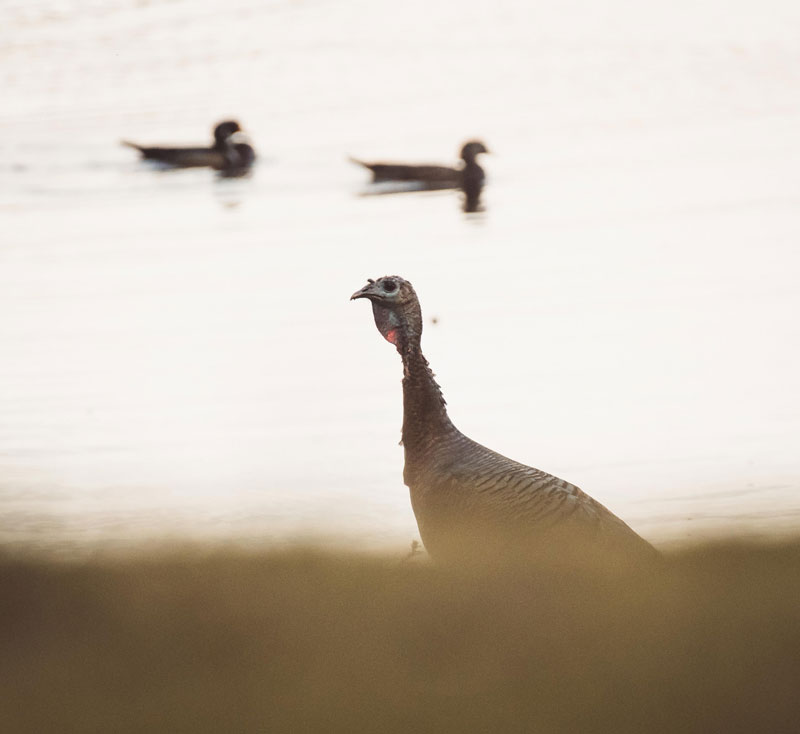
Image Credit: Tyler Hawley
Roosting a Turkey
Turkeys usually fly up to their roost trees at or just after sunset. They do this to get away from predators and danger.
Knowing this, one of the best turkey hunting tactics is to find the tree where your target tom roosts the night before your hunt. This strategy, called “roosting” or “putting a bird to bed,” allows you to position yourself in a spot that gets you closer to a turkey as they get off the roost.
The highest probability of success is first thing in the morning, especially when toms are roosted without a hen. Get as close as you can, but not close enough to risk busting the bird off the roost. It’s not always productive to be right underneath the tom you’re after because they see really well and any movement even in the dark will spook them.
When roosting, be sure to keep a safe 100- to 200-yard distance. Even if your target turkey comes off his roost in the opposite direction, you’ll still be in good position to call him in.
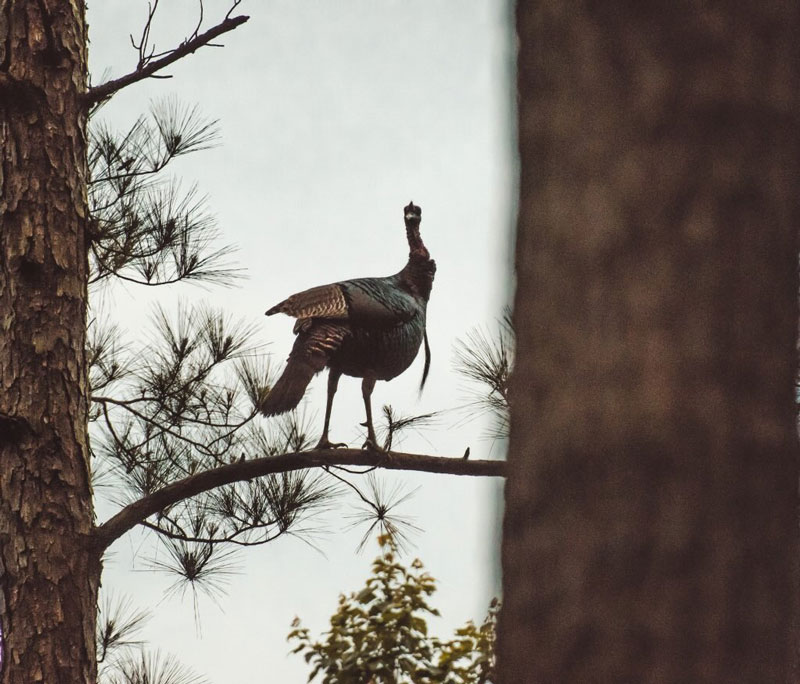
Image Credit: Tyler Hawley
3 – How To Turkey Hunt
Rifle, Shotgun, or Bow?
Your weapon of choice is up to you, so there is no right or wrong answer here. Rifles are allowed in a few states, but not all—so check your local rules and regulations before heading out on a turkey hunt with your rifle.
If you choose to hunt turkeys with a rifle, our Ranger is a terrific option! It comes chambered in .22 LR, .22 Magnum, and .17 HMR, which are all appropriate for turkeys.
When rifle hunting, shot placement is key as you’ll typically be further away, aiming at a smaller target. You’ll need to place your shot strategically to avoid damaging the meat.
If you want to use a shotgun, you’ll need to pattern it. Do your research to determine which brand of ammunition and which shot size will work best for your shotgun at various ranges. Different combinations of ammunition, firearms, and chokes will produce different patterns. There are a wide variety of loads on the market now. Copper-plated lead, bismuth, and tungsten are commonly used in turkey loads. They will all do the job.
What’s critical is knowing how your chosen load shoots out of your gun / choke combo before the season. Don’t be the person that wings it… literally. Identify the maximum range distance which you can shoot that produces a clean pattern to ethically harvest your bird.
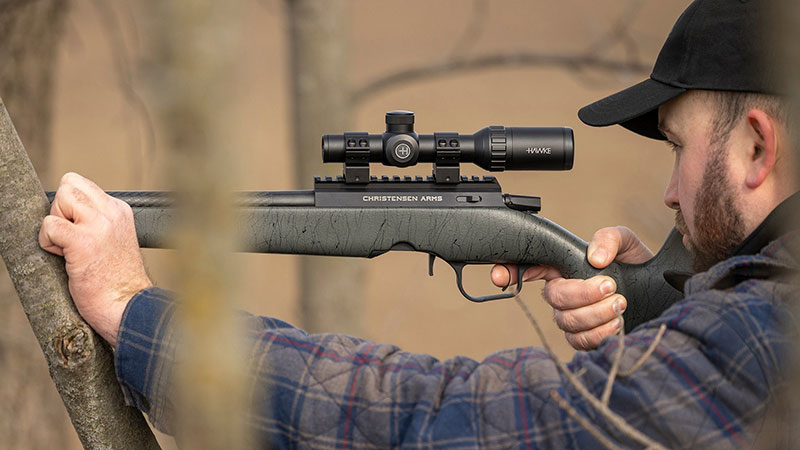
Image Credit: Hawke Optics
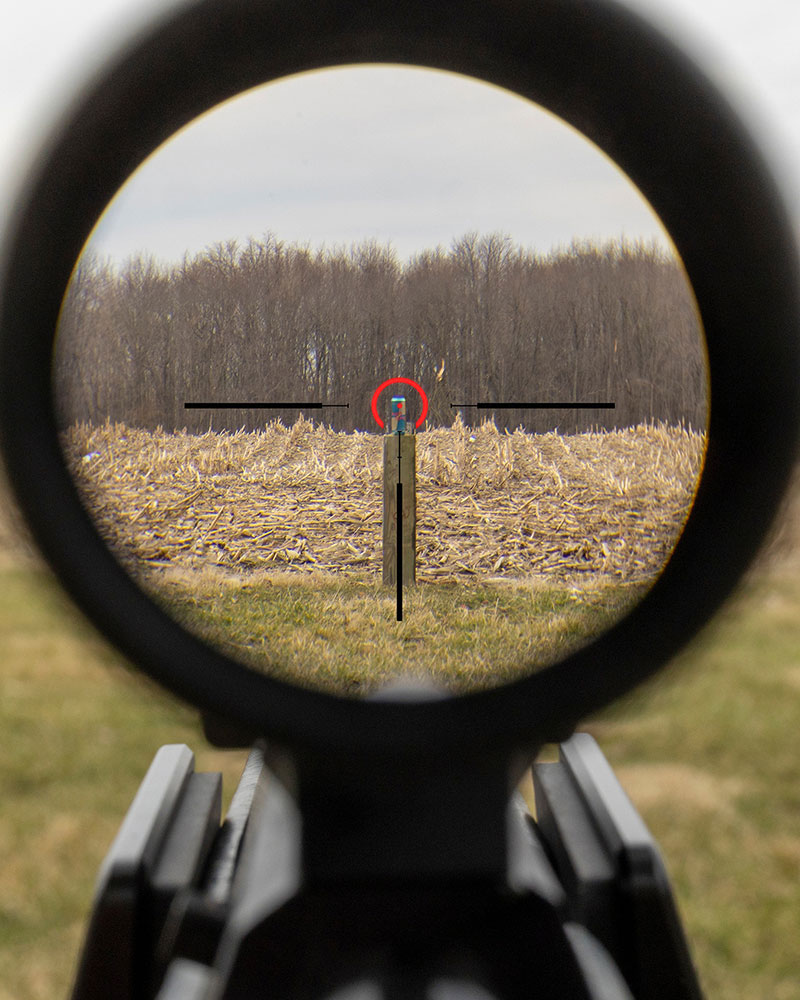
Image Credit: Hawke Optics
If you’re going to use a bow, you must be highly proficient with it to ethically harvest a turkey. Make sure you know your effective shooting range with the broadhead you plan to use. Some broadheads are designed for shooting at the turkey’s neck and head. These broadheads have a very limited range in which they fly accurately and are not meant for aiming at the body.
Other fixed blades and mechanical broadheads can be used to aim at the neck and head, or the vitals. It’s important to keep body posture in mind when body-shooting a turkey with a bow. A tom at full strut can be harder for the hunter to visualize where the vitals are.

Image Credit: Bowhunters United
Since penetration is generally not an issue for turkey hunting, a larger mechanical broadhead is popular among archers. This allows for more margin of error with shot placement.
Calling Turkeys
Calls are an essential part of turkey hunting and are typically used to mimic the sounds of a female turkey or a gobbling Tom, to bring them into close enough range to make a shot. In order to become an effective turkey caller, you need to learn to speak their language. Learn what sounds they make and what they mean. Some examples are:
- Cluck: One or more short notes. It’s used by one bird to get the attention of another and a good call to reassure an approaching gobbler that a hen is waiting for him.
- Purr: A sound made by hens when they are content and feeding. These can be used to relax a bird and get them to come the last few yards needed for a shot. A fighting purr is much louder and more aggressive than a regular purr.
- Yelp: The most common call used by turkeys to communicate with and find each other.
- Cutting: Combining sharp clucks with yelping. Hens often make these sounds when they’re excited or agitated. This loud call can be used to stir a reaction from a turkey to see if there’s one in the area, or used to get a stubborn gobbler to come in those final yards.
- Ki-ki-run: This can be effective in the early season and in the fall. This is an excited hen attempting to regather her group or has lost sight of the group.
- Gobble: One of the main sounds made by a male turkey. Commonly used to communicate with hens and lets them know he’s in the area.
Types of Turkey Calls
There are a lot of different types of turkey calls on the market. Everyone has their favorites, but it’s extremely beneficial to be proficient in at least a few types of calls.
We’ll break calls down into main three types:

Image Credit: Hazy Mountain Media
- Mouth Call (Diaphragm): A mouth call is basically a stretched latex reed(s) stamped into a tape that’s cut to fit the roof of your mouth. There are different configurations of reed cuts: latex stretch, number of reeds, and dome plates. Mouth calls allow for a wide array of sounds and they free up both hands so you can maintain a ready grip on your gun or bow. They’re also among the most versatile as far as volume and tone control. Every turkey hunter should pick up a few different styles to see what fits them best and routinely practice before the season. Once you find one that works, buy multiple. They often get lost and / or dirty, and you don’t want to be without them when it matters most!
- Pot and Striker: Utilizing friction between a wooden or plastic striker and an aluminum / glass / slate pot, this pot and striker calls are both user-friendly and extremely effective. They’re commonly called “slate calls.” Regardless of what material you choose, a pot and striker call will allow you to add a bit of reverb and pitch to the sounds you make that are hard to achieve with a mouth call. Slates also are great for purring and cutting. Note: these calls require hand movement, so be aware of the tom’s location as you call so he doesn’t spot you and run.
- Box Call: A box call is as simple as it sounds: a wooden box with a wooden lid handle that hinges side-to-side on a single screw and spring. The friction of the lid against the box makes the sound. This is the easiest call to learn and possibly the loudest of the three. Box calls are great for loud yelps and cuts used to locate gobblers on windy days. However, they’re the least versatile in terms of call variety and they require a lot of movement in comparison to the first two options—which may alert turkeys of your presence.
All three calls have their place. There are lots of other configurations to explore, as well, such as a push call, wing bone, or gobble tube. Calling is what makes turkey hunting exciting, so learn as much as you can before the season!
Want to learn more about turkey calling? Check out the video below:
Using Turkey Decoys
Decoys can be highly effective for attracting turkeys into range. If you’re going to buy decoys, make sure they look realistic. It’s worth paying more for good decoys. Buy once, cry once—as the saying goes. When researching and purchasing decoys, watch out for shiny paint and reflective materials that look unnatural. Turkeys have small brains but they aren’t stupid.
When setting up your decoys on a hunt, make sure they’re in a natural-looking position, set up at a distance to give you a clear shot. Also, keep in mind that different decoys command different responses. Some toms will sprint into the sight of a strutter decoy and a hen, instantly challenging what he assumes is an intruding bird. This will generate some trial-and-error situations as you progress on your hunting journey. A turkey’s reaction is very dependent on the bird’s age, aggression levels, mood, and more. Some toms will run at the sight of a decoy; others will try to fight it.
In an open setting, where a tom can see your spread from a few hundred yards, it can help to have multiple decoys spread apart to look as real as possible on his walk-in. Running and gunning in timber may call for fewer decoys and more calls. In thick cover, you’ll rarely need a decoy.

Image Credit: Tyler Hawley
Staying Concealed with Blinds and Good Camo
Be still. Turkeys have incredible eyesight that allows them to see movement very well. Their ability to pick out what doesn’t belong is unparalleled. Being completely concealed is key in turkey hunting. They see every little movement, so one false move often means the difference between eating turkey or tag soup.
Most of the excitement of turkey hunting is bringing a thundering tom up-close-and-personal, so dress accordingly. These are not colorblind deer, so cover your hands and face. In a ground blind, wear black and blend into the shadows.
Have Fun!
Turkey hunting is a great way to challenge yourself or just get out and have a good time with friends. It’s great for new and veteran hunters alike, and helps fill the void between deer and elk seasons.
Not only does hunting turkeys provide an opportunity to connect with nature and appreciate the beauty of the outdoors, it requires a great deal of strategy, patience, and skill—things that will make you a more educated and well-rounded hunter. Wild turkey is also a sustainable and ethical source of food for those who choose to consume it.
That’s all we’ve got, for now. Get out there and have some fun!
 since 1995
since 1995







